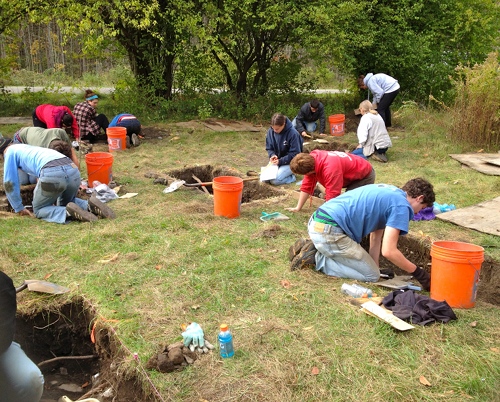
As a requirement for my anthropology major, I signed up for Fieldwork in Urban Archaeology, an introductory course offering fieldwork experience in a local setting. My interest was piqued when I learned we would be graded on our technical skills—something foreign to me as a humanities student used to lugging books.
Our first trip out to the research site, about fifteen minutes from campus, found us in the crook of a hairpin turn near the entrance to Robert Treman State Park. A recent flood had littered the area with rock and debris, making it hard to imagine that this muddy patch was home to the Rumsey family during the nineteenth century. Buried just inches beneath the ground were the remains of a once-vibrant hamlet that was abandoned when the region was converted to parkland around World War I.
The unmowed plot had dried out by the following week, when we were paired off and assigned to sites designated by pink spray-painted stakes plotting ten-by-ten-foot squares. Though we’d been supplied with shovels, buckets, and wire sifting screens, we quickly abandoned them in favor of using our bare hands to tear out the grass.
Hours later, after digging around a fieldstone in an attempt to get to the next layer of soil, my partner and I were tired and bored. Then we unearthed a handful of crumbly metal, the oxidized iron an orange stain in the dirt. Using our red and puffy hands, we pulled out two square nails, a piece of glass, a shard of porcelain, and a hog’s tooth. Shaking the metal screen and whispering, “Big money, big money!” we were rewarded with enough archaeological booty to fill a small paper bag.
Trotting over in a khaki vest and jeans, looking like she’d just walked off the pages of National Geographic, Professor Sherene Baugher announced: “Okay, open this up, you’ve got a unit.” Success! Our humble shovel test had been promoted to an official unit, a three-by-three-foot square of special interest. Assigned a new number and given more stakes, we traced out a larger box and scrambled to find the edges of the pesky fieldstone that had prevented us from digging any deeper.
My hands were sore and filthy as I scratched away at the silty soil, revealing more of the rock. After a few minutes of frowning at the obstinate mass, we reached the same conclusion: it must be a foundation stone from the Rumsey house! We tore at the dirt with a new vengeance.
Several weeks later, the class was absorbed in the excavation of the house foundation. All four walls emerged as we hauled out buckets of dirt containing countless artifacts: complete bottles, children’s toys, a wagon wheel, even porcelain imported from Germany. The objects speak volumes about the daily life of the Rumsey family and the community of Enfield Falls. From toy soldiers to farm tools, the artifacts enlightened me in ways a textbook never could. Not only did I have a rare interaction with a bygone culture, but I was inspired to imagine future students digging up artifacts from my own life. While washing the dirt from perfume bottles and tin cups, I wondered which of my possessions could become archaeological treasures. How will my sneakers and toaster hold up as time wears on, until their value shifts from ordinary to extraordinary? One thing’s for sure: I’ll never look at a rusty nail the same way again.
— Brooke LaPorte ’14


